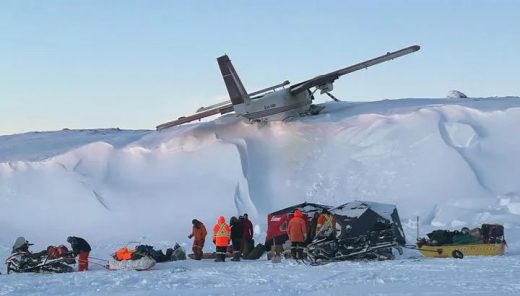
As a follow-up to last week’s report of the crash of an Air Tindi de Havilland Twin Otter while attempting to land on the frozen surface of Lac le Gras in the Northwest Territories on December 27 to deliver ice-road construction workers, new details have emerged.
“The flight crew was circling over the landing area, looking for snow drifts. They hadn’t committed to landing yet. They didn’t realize they had descended into basically a whiteout,” Air Tindi president Chris Reynolds told local news outlet Cabin Radio. “The only time they realized that they had descended was when they saw a hill in front of them, and that’s basically where they impacted.”
Reynolds went on to say, “Flying north of the treeline in Canada, with the featureless terrain and on skis, is some of the most difficult flying in the world. The flight crew that was flying it, particularly the captain, was probably one of the most experienced you can ever find in the area. So we have to take all that into account. It wasn’t a crewing issue or anything like that.”
“The weather was multiple little cloud layers, low visibility due to the blowing snow, as well as high winds,” said the CC-130H Hercules rescue aircraft commander Captain Jason Shaw. “By that point in the day, it was night as well. For me personally, this was probably the most difficult weather I’ve operated in.”
RCAF Search and Rescue Technician Sergeant Vincent C-Benoît led the Winnipeg-based SAR Tech crew in the rescue operation. He later told Cabin Radio that the 10 survivors’ setting up of a shelter and their placing of lights on the ground to guide rescuers demonstrated a high degree of preparation.
The 34-year-old Sgt. C-Benoît jumped with two colleagues from the Hercules to assist the crash survivors. Each was carrying up to 40 kg of gear. “It was the most challenging jump in my career, but we got good training and it’s something we train for every day,” said Sgt. C-Benoît. The SAR Techs were assisted on the ground when four employees of the Diavik diamond mine, located about 16 km away, arrived on snowmobiles later in the evening.
“It was quite the trouble for them at night and in the blizzard, but they were able to come and help and I was really happy to see them,” Sgt. C-Benoît told the CBC.
See lower down in this weeks’ update for two featured videos related to the Air Tindi rescue.
